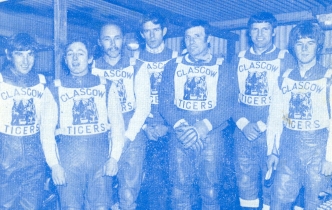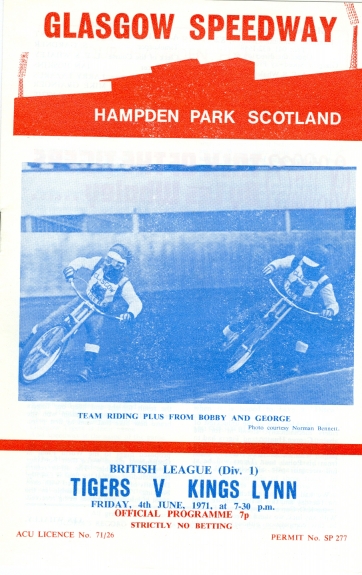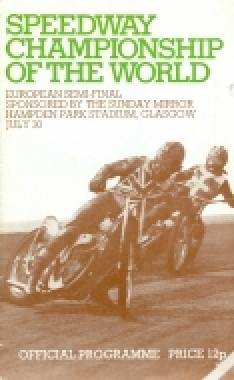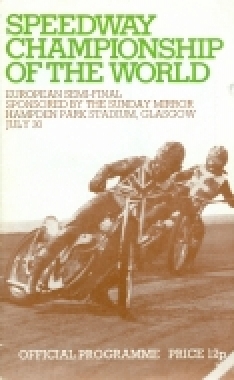1971 The NBF and All That
Look Who Is Joining the Tigers
It was an open secret that Oyvind Berg was going to seek a move from Hampden, which wasn’t really conducive to his style. He wasn’t a consistent gater and Hampden wasn’t an easy track on which to come from the back. He also had work reasons for heading down south. While it was assumed his request would be granted, getting a replacement would no doubt be problematic.
Ian Hoskins had run Newcastle on behalf of Allied Promotions during the 1970 season but it had not been a great success, with the Geordies never really recovering from the departure of Ivan Mauger and Ole Olsen in successive seasons. It was no surprise when Allied promotions moved the licence down to Reading, taking Michanek, Curtis and Lovaas south too. George Hunter wasn’t for joining this exodus and he was allocated to Glasgow, where he would be joined by none other than Ian Hoskins!
Tigers’ fans had very mixed views about this duo coming to Hampden. Both had often been villains, sometimes pantomime villains, in our local derbies with the Monarchs and it just didn’t seem right! . For some the speedway was never quite the same again. Oyvind Berg was probably the most loved Tiger of the Hampden era and his departure left a large void. However his replacement, the George Hunter of 1971 was in snappy and confident mode, in contrast to his time at Coatbridge. Clad in red leathers with a red and white jersey, he started the season in scintillating form, topping our score chart in the opening meetings and quickly won over a number of doubters.
Hoskins had a harder job. Although he had been a major shareholder in the Tigers since 1964, he had been so successful in adopting an arms length approach to his Glasgow involvement, that fans never thought of him as being part of the Tigers management. His role at Hampden was fairly limited. He had a page in the program – Hoskins Hampden Handbook – although it is possible that he may have penned Les Whaley’s editorial too! His match night function was that of announcer in the referees box replacing the departed Don Cumming – not a great role for such a natural showman.
…and who didn’t !
Barry Briggs in his book “Trackin’ with Briggo” tells that Phil Crump had planned to head to Glasgow when he first came over. Unfortunately, Neil Street pointed out the travelling involved and he signed up for Crewe, where he became an instant hit in Division Two. Oh what might have been!
All Tartan Line Up…or very nearly!
With George Hunter replacing Oyvind Berg, Tigers now boasted an All Scottish line up – if you subscribed to the still unproven assertion that Charlie Monk had a Scottish grannie or other such relative that conveniently qualified him as Scottish – not that it ever stopped him riding for his native Australia in test matches! Here they are the only All Tartan line up in our history

George Hunter; Jim McMillan; Bill McMillan; Charlie Monk; Doug Templeton; Willie Templeton; Bobby Beaton:
The Program
The previous years cover was improve with the addition of a silhouette outline of the Hampden main stand in the header. The Supporters Club finally surrendered their full page in favour of Hoskins’ “Hampden Handbook” a mix of news, match scores and supporters letters. The Supporters Club shared the back page with Bob Rae who wrote historical features, usually about the visitors.

Jim Beaton’s Debut
Jim Beaton had developed at the winter practices at Coatbridge and was the next “white hope” for the future. Just turned sixteen, Berwick were keen to sign him on loan and it seemed both a sensible and natural move to further his development. However the Tigers promotion was reluctant to loan him out as Berwick would then have first call on his services when Berwick and Glasgow fixtures clashed. This indecision persisted for the early weeks of the season. Perhaps the promotion was hoping they had another Tommy Miller on their hands! With Bill McMillan struggling for form in the early meetings, the promotion took the rather rash step to drop him in favour of young Jim, who had had only limited outings at Hampden. The move backfired rather badly with Tigers losing 41-37 to the visiting Poole Pirates. Jim scored two paid three but these points were at the expense of Tigers junior Walter “Wattie” Robertson who had been loaned to the Pirates to cover for the absent John Davis. While it certainly wasn’t Jim’s fault that the Tigers had lost –Doug Templeton and Charlie Monk were right out of touch, while Willie Templeton had to pull out of the meeting with a chest injury after scoring four from his first two rides- it was no surprise that Bill McMillan was reinstated for the following meeting.
The promotions misgivings about fixture clashes were justified as, after Bill McMillan’s retirement in early September, Jim was unavailable for two of the Tigers last three home meetings due to his Berwick commitments.
So Near and Yet So Far
While Tigers home record during 1971 was decidedly shaky, our away record showed numerous close calls but with little success.
In the opening six weeks of the season, Tigers won 40-38 at Cradley and posted scores of 37 at both Halifax and Hackney and a 38 at West Ham – really this was a meting we should have won! The Glasgow Fair saw Tigers ride in five away meetings in a fortnight. The first at Wolverhampton was a 43-35 defeat but in the remaining four we never scored less than 37, but never more than 38, which we did on three occasions at Oxford, Newport and Cradley. No wonder we were the leagues favourite visitors, always putting on a great show but rarely winning! These “ so near and yet so far “ situations did little to ease supporters’ dissatisfaction with our tail-end riders – just a couple more points and we would have won at least three away meetings.
Cup Success at last
No not winning the KO Cup! – that would have to wait until 1993! – after five years we finally managed to win a KO Cup Tie. It must be said that we had been drawn away for five consecutive years during 1966-1970, and in each case we got knocked out at the first attempt. In mid June Tigers beat Leicester 43-34 at Hampden, despite the best efforts of Ray Wilson and John Boulger with ten and twelve paid thirteen respectively.
Sadly Tigers cup progress came to an end in a last heat decider at Cradley, losing 40-38 at the end of July.
The Nordic British Final
Our opening home program referred to the event as the “Gothenburgh – British Final” – note the spelling. However the following week’s program had amended this to the expected “Nordic British Final” and an article in the “Hampden Handbook” page claimed it would be “the biggest speedway event in Scotland since the fabulous fifties” and went on to say that “whenever tickets become available, Tigers fans will have priority”! I don’t think a sell-out was ever on the cards!

Track - Ups and Downs
Track preparation at Hampden had always been quite tricky. The sun shone on most of the track, but the Main Stand caused the home straight to be in the shade at certain times of the day, while the roof on the West Enclosure meant that the third and fourth bend would also be shaded in late afternoon. Watering had to be carried out with this in mind, not an easy task! The football pitch had been widely criticised for its lack of quality and poor drainage. On one occasion when an evening game had been called off, Les Whaley said that the track would have been ok to stage a speedway meeting that night! The Hampden authorities decided to lift the entire pitch to install new drains and returf the whole pitch. For a few weeks the centre green looked pretty weird – bare earth and piles of drainage pipes. More importantly, track preparation time was severely limited. There was a constant stream of trucks and heavy plant, which really knocked chunks out of the track surface, particularly at the points where the access ramps met the track at either end of the home straight. The entry to the first bend was the most problematic. By early June, the state of the track was a cause for concern and a surprise home defeat by Kings Lynn led to a “closed doors” meeting between the riders and the promotion about track conditions. Things were made worse when, unannounced, the Hampden authorities cleared surplus shale off the terracing back onto the track the day before a meeting. Against this backdrop, it was not surprising that there was quite a rumble of discontent and a few veiled suggestions that the Nordic British Final should be held elsewhere. Don Clarke, whose paper the Sunday Mirror was sponsoring both the Nordic British and European finals, wrote a fairly provocative article along these lines in the paper in late June. This certainly upset some fans. However the pitch renovations had been completed and extensive work by James Beaton got the track back into good condition. He spent many days blading and grading the surface and at one point even tyre packed the track using one of his buses! I can vividly remember Neil Mcfarlane, also involved in the track work, jumping and punching the air in delight when Jim McMillan lowered the track record to 71.8 in early July. This ended mutterings from the south that the event should be held elsewhere. Jim’s time was never bettered and remains the record for Hampden to this day. Sadly, despite the track record being lowered more than two weeks before the Nordic British final, the program wasn’t updated to reflect this. The program cover actually referred to the meeting as the “European Semifinal”!
The Line Up
The Nordic Final was won by Ole Olsen, after the referee had over-ruled protests that he was using illegally cut tyres. Fellow Danes Bengt Norregaard and Kurt Bogh and Norwegian Reidar Eide completed the qualifiers. Odd Fossengen had pipped Oyvind Berg for the travelling reserve spot by virtue of more heat wins. Berg was, arguably, the most popular Tiger of the Hampden era. Although he had sought a transfer after two years of toiling on the narrow Hampden track, he would have been assured of a great reception.
Bert Harkins was a comfortable qualifier from the British Final, and, despite his Monarchs’ background, Tigers fans were prepared to get behind their fellow Glaswegian. A similar facility was never going to be extended to Reidar Eide though! Bert was in the form of his life, and, with the European Final being staged at Wembley, his home track, he had a very real chance of making it to a World Final……until he crashed in a second half heat at Wembley just six days before the Hampden meeting. Like compatriot McMillan, he had broken his collarbone. Unlike McMillan, he was going to take pain-killers and try and ride through the pain barrier.
The qualifiers from the British Final were Ivan Mauger, Barry Briggs, Tony Lomas, Bert Harkins, Ray Wilson, Martin Ashby, Ronnie Moore, Dave Younghusband, Bob Kilby, Eric Boocock, Nigel Boocock, and Jim Airey. Geoff Curtis and John Boulger would be the meeting reserves.
The Meeting
A crowd, reportedly close to ten thousand rolled up on a fine sunny night. The track seemed to be in good condition but it has to be said that the racing was largely processional, with the drama only coming in the final few heats.
Barry Briggs had a traumatic evening from the start. He had been riding for Swindon at Sheffield the night before, and, not for the first time on the eve of an important World championship event, had encountered mechanical problems. Briggo was never one for preparing a special bike for the World Championships and putting it away until the night! He didn’t have time to return to his Southampton home and was reduced to making running repairs in the Hampden pits on the afternoon of the meeting. Initially, they weren’t too successful, and, after two rides, had only one point to his name. Things looked better when he was leading his third ride, but then his steel shoe came adrift just as he was entering the bend and he fell. With one point from three starts, he needed to win both his remaining rides and hope that seven points would be enough to make the cut. He duly won these rides, his last being in heat seventeen, which meant he was among the first four to have completed his five rides. He was now scanning the program to see how others were doing.
Heat eighteen saw the unbeaten Ivan Mauger line up against Ole Olsen who had ten points, Eric Boocock on six and Bent Norregaard who was out of the hunt on one. The formbook would have suggested that Mauger and Olsen would have finished ahead of Boocock. The single point would have give Boocock seven, the same as Briggs but Briggo would have gained precedence having two heat wins. The formbook went completely out the window! On a night when passing was at a premium, Boocock promptly rode round both Mauger and Olsen, giving Mauger his first Hampden defeat of the year. It is believed that Boocock actually rode on Mauger’s spare bike in this race. He had now eclipsed Briggo’s total.
The next race brought high drama and emotion that is remembered vividly to this day! Ray Wilson and Nigel Boocock were both on ten points and a heat win would have given them thirteen points and the runners up prize. Also in the heat were Bert Harkins who had battled bravely to three points and Kurt Bogh who had surprised many and had four points. Bert was obviously drained after four races and wasn’t strong enough or fast enough to withstand Ray Wilson’s challenge and ended up on the floor. The crowd gave the English rider a tough time but really Bert’s hopes of qualifying had long since evaporated.
The fans were scrutinising their programs prior to heat twenty and working out the various permutations that could keep Barry Briggs in the World title hunt. He had appeared in the last seventeen World finals and, despite his tribulations, still had a chance of making it. The line up featured Bob Kilby who was out of contention with two points; Reidar Eide on four, including one heat win; Ronnie Moore on six and surprise package Tony Lomas on seven. If Eide won from Kilby and Moore the last two qualifiers would have been Eide and Briggs. However the tension got to Eide, a dubious starter at the best of times, and he broke the tapes, getting his second tapes exclusion of the night. The same fate befell Kilby. Reserves Odd Fossengen and Geoff Curtis were finally getting an outing in the last heat of the night. I don’t know if they were pleased or otherwise at this but Fossengen failed to beat the two minutes time allowance and was replaced by fellow reserve John Boulger. Curtis had an even more distressing time, looping at the gate. Ultimately, Moore won from Lomas and Briggs was eliminated.
The evening was rounded off in some style by a social event hosted by the Hampden branch of the Glasgow Supporters club, but, at the time, few of the home support appreciated that the night would prove to be the high water mark in the fortunes of Glasgow speedway and that things would go downhill quite quickly thereafter.
Les Stays at Home
In May Les Whaley had moved home to Bradford, where he promoted on Wednesdays at Odsal. He was finding that this commuting was very time consuming and by mid August decided to leave the running of the Tigers in the hands of fellow directors, Ian Hoskins and James Beaton.
Letters Page Aggro
Home defeats were very much a rarity during the 1969 and 1970 seasons and it would seem that Tigers fans took the Hampden defeats quite badly during the 1971 season. It certainly seemed so judging by the number and tone of letters submitted in their aftermath.
While the criticism following Poole Pirates winning at Hampden was quite muted “We must protest at the inclusion of Jim Beaton at the expense of Bill McMillan …Whilst Jim must be given opportunities it must not be at the expense of the team” – hardly fir and brimstone!
Kings Lynn’s surprise and pretty decisive 43-35 success in early June provoked the biggest postbag of the year and five were published. The over watered track and mechanical gremlins were the main topics, with one scribe wanting to drop poor performers but two others weren’t for axing anyone.
However when Belle Vue rode into town in early September, and, it has to be said, rode all over the Tigers, the postman’s bag was glowing red-hot! The main letter ran to nearly a full column – bet the supporters club wished he was about in the two preceding seasons! The writer certainly went into overdrive “We are all agreed that this is the worst set of second string riders we have ever had” …when are we going to replace these riders… I can’t see the support taking much more of this at Hampden….I don’t want to see speedway fold in Scotland” All stirring stuff, even if it did miss the point that Belle Vue had won eight away league fixtures and were runaway league leaders. It also chose to ignore that Doug Templeton had scored seven in the fateful meeting, or that Bill McMillan had retired during it – so obviously he was going to be replaced fairly soon!
Curiously all letters of this nature appeared in the program two weeks after the defeat rather than the following week’s one, which suggests the letters page was compiled well I advance of the rest of he program.
Bill McMillan Retires
After being dropped in favour of Jim Beaton for the home meeting against Poole at the end of April, Bill McMillan was an ever present until the middle of August. He was promoted into the team for the double header against Sheffield and Oxford but was right out of luck. He crashed into the safety fence while avoiding Doug Wyer who had seized up right in front of him, sustaining a cracked bone in his wrist. He reported fit for the Poole/ Wimbledon trip just under two weeks later, but had a pretty dire time at these venues and then faced the overnight drive back home from London, so no doubt wasn’t in the best frame of mind for the visit of the league leading Belle Vue Aces. Really nothing went right for the Tigers that night in early September. Monk, Willie Templeton and Bill McMillan were all toiling badly but the decision to pull a double tactical move in heat eight replacing Monk with Hunter and Bill McMillan by brother Jim seemed overkill particularly as Aces were tracking Ken Eyre who hadn’t beaten a Tiger in two starts. Similarly giving the hitherto pointless Bobby Beaton an extra ride in the following heat against Ivan Mauger seemed hard to justify. A lot of hard words and home truths were being dispensed in the Tigers’ side of the pits, with the upshot being that Bill McMillan deciding he had had enough and was calling it quits. Hoskins rather gracelessly announced that Bill McMillan had retired but that no one retired on him during a meeting and that he had sacked him! However you cut it, Bill had ridden his last speedway race. At Hampden, he never quite reached the heights that he had scaled in his White City years but still provided a solidity at second reserve that the Tigers had missed since moving to Hampden.
Hoskins Black Ball
With the Scottish Open Championship looming up, Ian Hoskins was determined that the winner “would not only be the best starter but a rider who is capable of coming from the back as well”. Presumably he was concerned that Ivan Mauger was well nigh unbeatable around Hampden. His electric gating meant that it would take a herculean effort to pass him around the narrow Hampden track. He came up with the idea of making each rider start once from a ten yard handicap. The program for the week preceding the Scottish Open stated “Following the public vote last Friday all riders will be handicapped ten yards in one of their races”. Public vote – hardly! He announced his plan to the crowd and, at best, got a lukewarm reception to it. Indeed some spectators in the centre stand area tried to shout it down! But to no avail.
In heats 5 to 20, one rider will draw a black ball and be given a handicap. It seems likely that the draw was “managed” as there was no reason that all four riders in a latter heats hadn’t all already selected the dreaded black ball. It certainly had the desired affect as Ivan Mauger conceded ten yards in heat ten to Michanek, Airey and Eric Boocock and could only manage a third place. The following heat saw Jim McMillan make light of he backmark to finish ahead of Hunter, Beaton and Louis, leaving him as the only unbeaten rider after three rides. Things went awry thereafter as both Mauger and Eide headed him in their respective heats. This meant McMillan was tied with Mauger on thirteen points. In the run off, Mauger made his usual jet start and won easily. Hoskins plotting had come to nought!
The League Season at a Glance:
Home Defeats: Poole 37-41; Kings Lynn 35-43; Belle Vue 32-46:
Home Draw: Halifax 39-39:
Away Win: Cradley 40-38:
League Position: Fourth bottom, with 31 points from 36 meetings.
B.L.R.C Joy Night
In mid September, Ian Hoskins wrote that Jim McMillan was off form but that he had seen this happen to “umpteen” stars over the years. He had no doubt that his form would return, and so it proved in the following weeks. However none of the numerous Tigers fans who were at Belle Vue on the 16th October could have expected the night to unfold as it did. Tigers fans had travelled down in huge numbers and had booked the entire “N” block, a detached stand situated halfway down the back straight, and at times they made as much noise as the rest of the stadium put together
Jim got off to a fair start with a second place behind Anders Michanek in heat one…..
Barry Briggs had won this event for the last six years since its inception in 1965 but despite that Ivan Mauger riding on his home track was the pre meeting favourite,
Barry Briggs got the better of him in the run off for second place but at least he had a place on the rostrum, the only time a Tiger ever managed this at the BLRC

